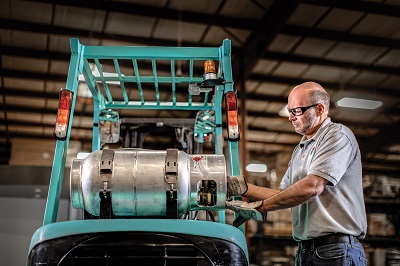Other Voices: Keeping propane forklift safety top of mind
Even in a busy warehouse or distribution center, reinforcing safety measures should never take a back seat.

Editor’s Note: The following column by Jeremy Wishart, deputy director of business development for the Propane Education & Research Council, is part of Modern’s Other Voices column. The series features ideas, opinions and insights from end-users, analysts, systems integrators and OEMs. Click here to learn about submitting a column for consideration.
———
Propane-powered forklifts are common across the industry for their versatility, quick refueling time, and the capability to run at 100% throughout operation. Because of this, they’re often called upon to work around the clock to keep businesses on schedule. Although safe operation of a forklift should always be top of mind for operators, reinforcing safety measures can sometimes take a back seat to meeting the needs of a busy warehouse or distribution center.
Taking a few minutes to reinforce these simple safety practices can help keep forklift operators safe when using propane forklifts.
Wear safety protection. Wear appropriate safety protection as required by OSHA and your employer, which may include safety glasses and gloves when handling cylinders.
Inspect the cylinders. Thoroughly inspect the forklift’s propane cylinders after removal from a storage cage to ensure good condition. Check cylinders for rusting, dents and gouges. Use senses of smell, sound and sight to check for leaks on the cylinder. Check that the pressure relief valve fitting is approximately 180 degrees from the forklift’s locating pin, and is secure.
Handle the cylinders safely. Use proper lifting techniques to remove and place propane cylinders on forklifts.
Store cylinders securely. Propane cylinders should be stored in a secured storage rack or cage when not in use on a forklift, with pressure relief valves in the uppermost position.
Close cylinder valves. When a propane forklift is not in use, close all valves on the propane cylinder.
Check the manual. Have operators periodically review the forklift operators’ manuals for manufacturer- or model-specific information before operating the machine. The practice of rereading the manuals on occasion can help keep safe operation top of mind.
Follow maintenance schedules. Staying on top of maintenance keeps machines at peak performance. Damaged engine or exhaust components can impact fuel economy and emissions, including carbon monoxide. Propane forklifts should otherwise emit levels of carbon monoxide below those required by OSHA.
Operate with proper ventilation. Because propane forklifts use internal combustion engines, some carbon monoxide is emitted, albeit at a much lower level compared to other internal combustion engine fuels. For propane forklifts used both indoors and outdoors, a simple solution is making sure ventilation is provided to warehouses where forklifts are in operation.
Start a checklist. To further reinforce the importance of safety at a facility, use the tips above to create a daily safety checklist and post it in a high-traffic area of the facility where employees will see it often.
Never stop learning. Encourage operators to receive ongoing training by reviewing current forklift operator safety training courses and materials provided by manufacturers, OSHA, and the American National Standard Institute/Industrial Truck Standards Development Foundation.
Propane forklifts can provide a number of benefits to companies, and keeping safety top of mind for operators and managers can be key in keeping business moving forward. More information on safety procedures for operating propane forklifts can be found in manufacturers’ manuals and standards such as OSHA 1910.178 and ANSI/ITSDF B56.1-2009. To learn more about the benefits of propane forklifts, visit propane.com/industrial.
You can view the selection of Safety Products on our sister site MHPN

Article Topics
Latest in Logistics
Shipment and expenditure decreases trend down, notes Cass Freight Index March trucking tonnage trends down, reports ATA FTR Shippers Conditions Index enters negative territory DAT March Truckload Volume Index sees modest March gains National diesel average, for week of April 22, is down for the second straight week UPS reports first quarter earnings decline LM Podcast Series: Assessing the freight transportation and logistics markets with Tom Nightingale, AFS Logistics More LogisticsSubscribe to Logistics Management Magazine

Find out what the world's most innovative companies are doing to improve productivity in their plants and distribution centers.
Start your FREE subscription today.
April 2023 Logistics Management

Latest Resources














